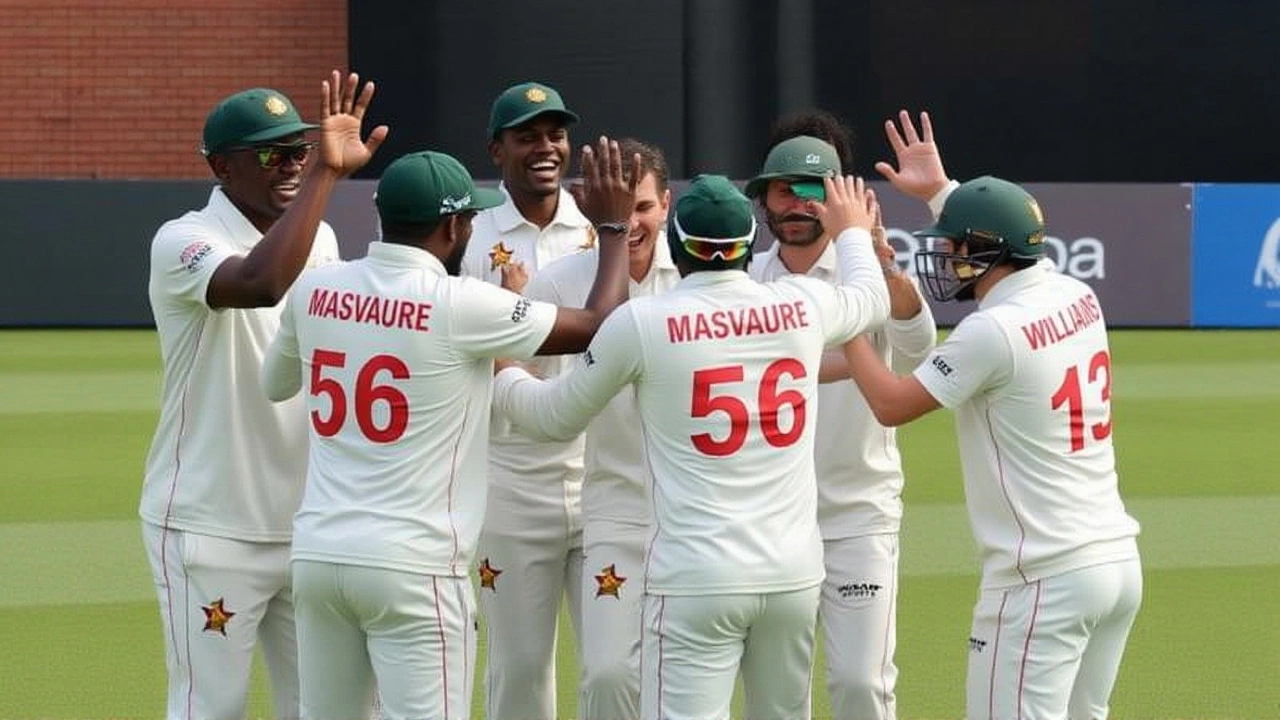Afghanistan Stuns Zimbabwe by 53 Runs in T20 Opener After Test Win

Just nine days after crushing Afghanistan by an innings and 73 runs in a dominant Test victory, Zimbabwe collapsed spectacularly in their opening Twenty20 International Harare Sports Club match, bowled out for 127 as Afghanistan chased down 180/6 with ease. The shock loss — a 53-run defeat — exposed a glaring inconsistency in Zimbabwe’s top order, even as their bowlers had looked dominant just days earlier. It’s rare for a team to follow an innings victory with such a brittle performance in the next format, but that’s exactly what happened here.
A Test High, a T20 Low
On October 20, Zimbabwe had announced their arrival as a force in Test cricket, dismissing Afghanistan for 127 and 159 to win by an innings and 73 runs. Brad Evans took 5/22 in the first innings — his maiden Test five-wicket haul — while Z Rahman chipped in with 5/81. Brendan Curran anchored the innings with a gritty 50, and Zimbabwe’s 359/10 looked insurmountable. Fans left the ground believing this was a turning point.Then came October 29. The same ground. The same opponents. A completely different story.
How Afghanistan Built Their Total
Afghanistan’s innings was a masterclass in controlled aggression. Openers Rahmanullah Gurbaz and Ibrahim Zadran put on 62 in 7.4 overs before Gurbaz fell for 34. Sikandar Raza, Zimbabwe’s best bowler, struck three times — including the key wicket of captain Mohammad Nabi for 28 — but couldn’t stop the momentum. Hashmatullah Shahidi top-scored with 58 off 42 balls, hitting seven fours and three sixes. Even the tail held firm: Abdul Rahman smashed 22 off 11, and Naveen-ul-Haq finished with 19 not out off 10. The final 20 runs came in just 1.4 overs — a reminder of how deadly Afghanistan’s lower order has become.Zimbabwe’s Batting Meltdown
Zimbabwe’s reply was a disaster. Four of their top five — including the captain (still unnamed in official reports), Brandon Taylor, Ryan Burl, and Tadiwanashe Marumani — all fell for zero. No one could handle the pace and spin combination of Abdul Rahman (3/21) and Hasan Ratib (2/18). The only resistance came from Tinotenda Maphosa (32) and Brian Bennett (24). The rest? Gone before the 17th over. Zimbabwe’s run rate of 7.82 in the first innings became 7.81 in the second — a sign of paralysis, not pressure.What Went Wrong?
The contrast is jarring. In the Test, Zimbabwe’s batsmen showed patience and resilience. In the T20, they looked lost. Analysts point to a lack of T20-specific preparation. Unlike Afghanistan — who’ve been playing T20 leagues across the globe since 2020 — Zimbabwe’s domestic T20 structure remains underfunded. The Chevrons’ top order, built for Test cricket, simply didn’t adapt. Raza, a world-class all-rounder, managed just one run with the bat after taking three wickets. That’s not a fluke — it’s a systemic issue.Meanwhile, Afghanistan’s squad is deeper. They’ve got players like Ikram Ali Khil and Abdul Rahman who’ve played in the IPL, PSL, and BBL. They know how to score quickly under pressure. Zimbabwe? They’re still learning.

What’s Next?
The second T20I is scheduled for Friday, October 31, 2025, at 11:30 AM GMT — same venue, same pressure. Zimbabwe’s coach, David Graveney, has called for "mental reset," but the clock is ticking. If they lose again, the series will be over before the final match on November 2. Afghanistan, meanwhile, are riding a wave of confidence. Their captain, Hashmatullah Shahidi, said after the match: "We didn’t come here to win one game. We came to show we belong in the top 10, no matter the format."For Zimbabwe, this isn’t just about losing a match. It’s about identity. Can they be a Test powerhouse and a T20 also-ran? Or is this the moment they realize they need to rebuild their entire approach to white-ball cricket?
Behind the Scenes
All matches are being streamed live by FanCode, with over 1.2 million viewers tuning in for the T20 opener — a record for a Zimbabwe-hosted T20I. The Zimbabwe Cricket board is under pressure. Funding for the national team has dropped 18% since 2022. Meanwhile, the Afghanistan Cricket Board has invested heavily in youth academies and overseas exposure. The result? A team that’s now more consistent than ever.Harare Sports Club, once a fortress for Zimbabwean cricket, now feels like a stage for a changing of the guard. The same pitch that hosted 359 runs in the Test saw 127 all out in 16 overs. That’s not just a collapse — it’s a warning.
Frequently Asked Questions
Why did Zimbabwe’s top order collapse so badly in the T20 after dominating in the Test?
Zimbabwe’s top batsmen were groomed for Test cricket — patient, defensive, and slow to accelerate. In T20s, the game demands immediate aggression, especially against Afghanistan’s varied spin and pace attack. Four of their top five scored zero, revealing a lack of adaptation to the format’s pace. Their domestic T20 league lacks high-level competition, leaving them underprepared.
How has Afghanistan improved so dramatically in T20 cricket?
Afghanistan’s rise stems from years of investment in youth academies and overseas exposure. Players like Hashmatullah Shahidi and Abdul Rahman have played in the IPL, PSL, and BBL, gaining experience against elite bowlers. Their coaching staff prioritizes T20-specific skills — power-hitting, death bowling, and situational awareness — giving them a clear edge over teams like Zimbabwe, who still prioritize Test cricket.
Who are the key players to watch in the remaining matches?
For Afghanistan, keep an eye on Hashmatullah Shahidi (batting) and Naveen-ul-Haq (bowling) — both are in top form. For Zimbabwe, Tinotenda Maphosa and Brian Bennett showed fight, but Sikandar Raza must deliver with both bat and ball. If Zimbabwe’s captain doesn’t step up, the series could be lost before the final game.
What does this result mean for Zimbabwe’s ICC rankings?
Zimbabwe is already ranked 11th in T20Is — just above associate nations. A second loss would put them in danger of falling to 12th, behind teams like Scotland and Nepal. With the 2026 T20 World Cup qualifiers approaching, every match counts. A 3-0 sweep by Afghanistan would be a historic low, signaling a need for urgent structural reform in Zimbabwean cricket.
Why is Harare Sports Club significant in this series?
It’s Zimbabwe’s most historic cricket ground, having hosted Tests since 1992. But this series exposed its vulnerability: the pitch, traditionally slow and helpful to spin, favored Afghanistan’s leg-spinners and slower balls. Zimbabwe’s batsmen struggled to adjust, while Afghanistan’s players, used to similar conditions in the UAE and India, thrived. The venue didn’t change — but the teams’ readiness did.
Can Zimbabwe still turn this series around?
It’s possible, but unlikely. They need to completely overhaul their T20 batting mindset — perhaps promoting all-rounders like Raza or Maphosa higher. If they don’t score above 160 in the next match, they’ll be out of contention. Afghanistan’s momentum is building, and their confidence is sky-high. Zimbabwe’s window to respond is closing fast.